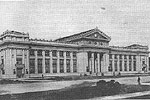|

Lower
West Side (continued)
The relocation of the Western Electric Company from
I2th and Clinton to suburban Cicero in 1903 had important consequences
for the future of this part of the Lower West Side. Just as the
McCormick Reaper Works had been one of the area's main employers
in the 1870s, the Western Electric Company provided jobs for thousands
of area residents Moreover, the extension of the Metropolitan
branch of the Douglas Park "L" to Cicero Avenue in 1907
offered fast inexpensive transportation to the Hawthorne plant
and nearby factories. The population of South Lawndale grew rapidly
as new homes and two-Hats were constructed on Marshall and Sacramento
Boulevards and along the side streets between Western and Crawford
(Pulaski) Avenues As Bohemians moved into South Lawndale they
established new institutions and transplanted old ones. The Hubbard
Memorial Bohemian Presbyterian Church for example, traced its
roots to the John Hus Methodist Church established in 1891 at
24th and Sawyer. In 1915 the congregation dedicated a new church
at 2520 S Lawndale Bohemian Catholics who moved to South Lawndale
did not care to worship at the English-speaking parish of Blessed
Sacrament at 22nd and Central Park. Instead, they formed two new
parishes, St. Ludmilla (1891) at 24th and Albany and Blessed Agnes
(1904) at 27th and Central Park. These Bohemian congregations
built massive churches as well as parochial schools.
Just as they had in Pilsen, sokols and "free thought"
schools took root in Czech California. Sokol Chicago, 2345 S.
Kedzie, and Sokol Havlicek-Tyrs at 2619 S. Lawndale were important
recreation and cultural centers in the new Bohemian neighborhood.
In addition to supporting Czech language classes at Harrison
and Farragut high schools, the community
also maintained free thought schools such as Vojta Naprster,
2548
S. Homan, and Jan Neruda, 2659 S. Karlov (See Fig. 1).
Anton Cermak, the Lower West Side's most prominent politician,
served as chairman of the Cook County Board before being elected
mayor of Chicago in 1931. Cermak was responsible for the construction
of a $7.5 million Criminal Court building at 26th and California,
which opened-in his ward-on April 1, 1929. In 1871 this location
was so remote from the center of the city that officials deemed
it an appropriate spot for Chicago's bridewell, formerly at Polk
and Wells Streets. Sixty years later the area was still Inaccessible
by public transportation. According to one publication:
To get to the loop from this area is a tedious proposition
at the best. Blue Island avenue cars on 26th street offer practically
the only method.
But lack of convenient transportation to downtown Chicago did not hamper
residential development. By the 1920s, the area around Marshall Boulevard
had been completely built up. Indeed, when the parish of St. Roman was
established in 1928 to relieve overcrowding at the older Polish parish
of St. Casimir, there was no vacant land in the area. Eleven houses had
to be razed to make way for the new church at 23rd and Washtenaw.
« previous 8 of 13 next »
|
 |

|
 |


Figure 1:
The new Carter H. Harrison Technical High School at the intersection of
Marshall and 24th Boulevards, c. 1916. »
|